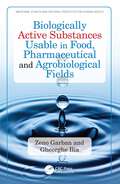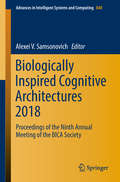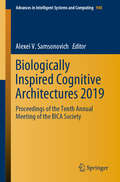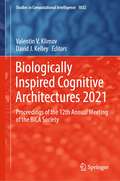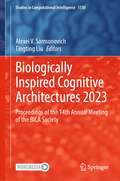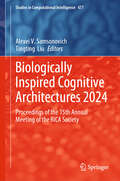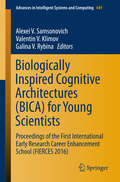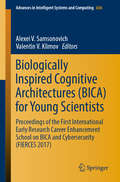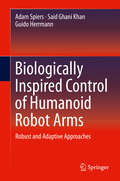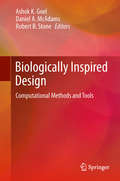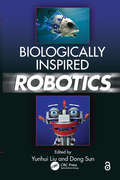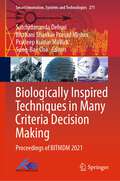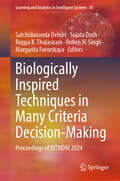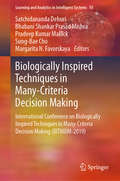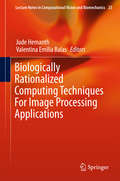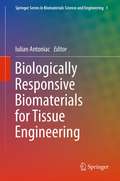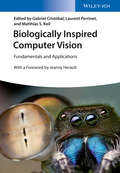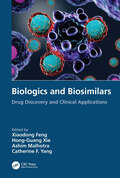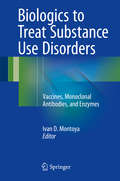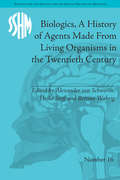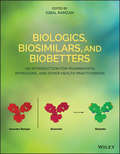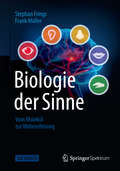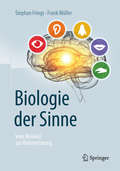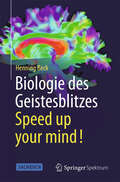- Table View
- List View
Biologically Active Substances Usable in Food, Pharmaceutical and Agrobiological Fields (Medicinal Plants and Natural Products for Human Health)
by Zeno Garban Gheorghe IliaThis concise text on biologically active substances of the food, pharmaceutical and agricultural industries presents data on natural compounds of vegetable and animal origin. Various nutrients in food, phytochemicals and zoochemicals are discussed, including their uses for prophylactic, metaphylactic and therapeutic purposes in personalized medicine. Along with these compounds, prebiotics isolated by biotechnological methods from plant tissues are reviewed, with the aim of obtaining compounds with an oligoglucide structure. Metabolism of nutrients and the biodegradation of xenobiotics are hot topics and access routes into the human body for the various biologically active substances are covered.Features: Biologically active substances and related chemistry, biochemistry and agrochemistry data are rigorously discussed Data regarding natural compounds of vegetable origin detected from plants present in the spontaneous flora and plants obtained in agricultural crops (medicinal plants, aromatic plants and more) are presented Discusses the natural compounds of animal origin detected in the organisms of some terrestrial and aquatic animals Covers prebiotics isolated by technological and biotechnological methods from plant tissues, with the aim of obtaining compounds with oligoglucide structure Broad audience including all those in biochemistry, the food and pharmaceutical industries and agricultural fields
Biologically Inspired Cognitive Architectures 2018: Proceedings Of The Ninth Annual Meeting Of The Bica Society (Advances In Intelligent Systems and Computing #848)
by Alexei V. SamsonovichThe book focuses on original approaches intended to support the development of biologically inspired cognitive architectures. It bridges together different disciplines, from classical artificial intelligence to linguistics, from neuro- and social sciences to design and creativity, among others. The chapters, based on contributions presented at the Ninth Annual Meeting of the BICA Society, held in on August 23-24, 2018, in Prague, Czech Republic, discuss emerging methods, theories and ideas towards the realization of general-purpose humanlike artificial intelligence or fostering a better understanding of the ways the human mind works. All in all, the book provides engineers, mathematicians, psychologists, computer scientists and other experts with a timely snapshot of recent research and a source of inspiration for future developments in the broadly intended areas of artificial intelligence and biological inspiration.
Biologically Inspired Cognitive Architectures 2019: Proceedings of the Tenth Annual Meeting of the BICA Society (Advances in Intelligent Systems and Computing #948)
by Alexei V. SamsonovichThe book focuses on original approaches intended to support the development of biologically inspired cognitive architectures. It bridges together different disciplines, from classical artificial intelligence to linguistics, from neuro- and social sciences to design and creativity, among others. The chapters, based on contributions presented at the Tenth Annual Meeting of the BICA Society, held in on August 15-18, 2019, in Seattle, WA, USA, discuss emerging methods, theories and ideas towards the realization of general-purpose humanlike artificial intelligence or fostering a better understanding of the ways the human mind works. All in all, the book provides engineers, mathematicians, psychologists, computer scientists and other experts with a timely snapshot of recent research and a source of inspiration for future developments in the broadly intended areas of artificial intelligence and biological inspiration.
Biologically Inspired Cognitive Architectures 2021: Proceedings of the 12th Annual Meeting of the BICA Society (Studies in Computational Intelligence #1032)
by Valentin V. Klimov David J. KelleyThe book focuses on original approaches intended to support the development of biologically inspired cognitive architectures. It bridges together different disciplines, including artificial intelligence, linguistics, neuro- and social sciences, psychology and philosophy of mind, among others. The chapters are based on contributions presented at the 12th Annual Meeting of the BICA Society (BICA 2021), which consisted of two parallel virtual events: Information in Biologically Inspired Cognitive Architectures based Systems, held during the 2021 Summit of the International Society for the Study of Information, on September 12-19, 2021, from Vienna, Austria, and the 2021 International Workshop on Biologically Inspired Cognitive Architectures, held during the 21st ACM International Conference on Intelligent Virtual Agents, on September 14-17, 2021, from the Fukuchiyama City, Kyoto, Japan. The book discusses emerging methods, theories and ideas towards the realization of general-purpose humanlike artificial intelligence or fostering a better understanding of the ways the human mind works. It provides engineers, mathematicians, psychologists, computer scientists and other experts with a timely snapshot of recent research and a source of inspiration for future developments in the broadly intended areas of artificial intelligence and biological inspiration.
Biologically Inspired Cognitive Architectures 2023: Proceedings of the 14th Annual Meeting of the BICA Society (Studies in Computational Intelligence #1130)
by Alexei V. Samsonovich Tingting LiuThe book focuses on original approaches intended to support the development of biologically inspired cognitive architectures. It bridges together different disciplines, including artificial intelligence, linguistics, neuro- and social sciences, psychology and philosophy of mind, among others. The chapters are based on contributions presented at the 2023 Annual International Conference on Brain-Inspired Cognitive Architectures for Artificial Intelligence (the 14th Annual Meeting of the BICA Society, BICA*AI 2023), organized in collaboration with the University of Ningbo and held on October 13-15, 2023, in Ningbo, China. The book discusses emerging methods, theories and ideas towards the realization of general-purpose humanlike artificial intelligence or fostering a better understanding of the ways the human mind works. It provides engineers, mathematicians, psychologists, computer scientists and other experts with a timely snapshot of recent research and a source of inspiration for future developments in the broadly intended areas of artificial intelligence and biological inspiration.
Biologically Inspired Cognitive Architectures 2024: Proceedings of the 15th Annual Meeting of the BICA Society (Studies in Computational Intelligence #477)
by Alexei V. Samsonovich Tingting LiuThis book reports on original approaches intended to support the development of biologically inspired cognitive architectures. It bridges together different disciplines, including artificial intelligence, linguistics, neuro- and social sciences, psychology and philosophy of mind, among others. The chapters are based on contributions presented at the 2024 Annual International Conference on Brain-Inspired Cognitive Architectures for Artificial Intelligence (the 15th Annual Meeting of the BICA Society, BICA*AI 2024), organized in collaboration with the 17th Conference on Artificial General Intelligence (AGI 2024) and held on August 13-16, 2024, in Seattle, WA, USA. They cover emerging methods, theories and ideas towards the realization of general-purpose humanlike artificial intelligence or fostering a better understanding of the ways the human mind works. All in all, this book provides engineers, mathematicians, psychologists, computer scientists and other experts with a timely snapshot of recent research and a source of inspiration for future developments in the broadly intended areas of artificial intelligence and biological inspiration.
Biologically Inspired Cognitive Architectures: Proceedings of the First International Early Research Career Enhancement School (FIERCES 2016) (Advances in Intelligent Systems and Computing #449)
by Alexei V. Samsonovich Valentin V. Klimov Galina V. RybinaThis book presents cutting-edge research focused on current challenges towards the realization of Biologically Inspired intelligent agents, or Cognitive Architectures (BICA). The chapters are written by both world-recognized experts (including Antonio Chella, Olivier Georgeon, Oliver Kutz, Antonio Lieto, David Vernon, Paul Verschure, and others) and young researchers. Together, they constitute a good mixture of new findings with tutorial-based reviews and position papers, all presented at the First International Early Research Career Enhancement School on Biologically Inspired Cognitive Architectures (FIERCES on BICA 2016), held April 21-24 in Moscow, Russia. Most works included here cross boundaries between disciplines: from neuroscience to social science, from cognitive science to robotics, and from bioengineering to artificial intelligence. A special emphasis is given to novel solutions to urgent problems that have been resisting traditional approaches for decades. Intended for providing readers with an update on biologically inspired approaches towards the computational replication of all the essential aspects of the human mind (the BICA Challenge), this book is expected to foster lively discussions on the topic and stimulate cross-disciplinary, cross-generation and cross-cultural collaboration.
Biologically Inspired Cognitive Architectures: Proceedings of the First International Early Research Career Enhancement School on BICA and Cybersecurity (FIERCES 2017) (Advances in Intelligent Systems and Computing #636)
by Alexei V. Samsonovich Valentin V. KlimovThis book presents cutting-edge research focused on current challenges towards the realization of Biologically Inspired intelligent agents, or Cognitive Architectures (BICA). The chapters are written by both world-recognized experts (including Antonio Chella, Olivier Georgeon, Oliver Kutz, Antonio Lieto, David Vernon, Paul Verschure, and others) and young researchers. Together, they constitute a good mixture of new findings with tutorial-based reviews and position papers, all presented at the First International Early Research Career Enhancement School on Biologically Inspired Cognitive Architectures (FIERCES on BICA 2016), held April 21-24 in Moscow, Russia. Most works included here cross boundaries between disciplines: from neuroscience to social science, from cognitive science to robotics, and from bioengineering to artificial intelligence. A special emphasis is given to novel solutions to urgent problems that have been resisting traditional approaches for decades. Intended for providing readers with an update on biologically inspired approaches towards the computational replication of all the essential aspects of the human mind (the BICA Challenge), this book is expected to foster lively discussions on the topic and stimulate cross-disciplinary, cross-generation and cross-cultural collaboration.
Biologically Inspired Control of Humanoid Robot Arms: Robust and Adaptive Approaches
by Adam Spiers Said Ghani Khan Guido HerrmannThis book investigates a biologically inspired method of robot arm control, developed with the objective of synthesising human-like motion dynamically, using nonlinear, robust and adaptive control techniques in practical robot systems. The control method caters to a rising interest in humanoid robots and the need for appropriate control schemes to match these systems. Unlike the classic kinematic schemes used in industrial manipulators, the dynamic approaches proposed here promote human-like motion with better exploitation of the robot's physical structure. This also benefits human-robot interaction. The control schemes proposed in this book are inspired by a wealth of human-motion literature that indicates the drivers of motion to be dynamic, model-based and optimal. Such considerations lend themselves nicely to achievement via nonlinear control techniques without the necessity for extensive and complex biological models. The operational-space method of robot control forms the basis of many of the techniques investigated in this book. The method includes attractive features such as the decoupling of motion into task and posture components. Various developments are made in each of these elements. Simple cost functions inspired by biomechanical "effort" and "discomfort" generate realistic posture motion. Sliding-mode techniques overcome robustness shortcomings for practical implementation. Arm compliance is achieved via a method of model-free adaptive control that also deals with actuator saturation via anti-windup compensation. A neural-network-centered learning-by-observation scheme generates new task motions, based on motion-capture data recorded from human volunteers. In other parts of the book, motion capture is used to test theories of human movement. All developed controllers are applied to the reaching motion of a humanoid robot arm and are demonstrated to be practically realisable. This book is designed to be of interest to those wishing to achieve dynamics-based human-like robot-arm motion in academic research, advanced study or certain industrial environments. The book provides motivations, extensive reviews, research results and detailed explanations. It is not only suited to practising control engineers, but also applicable for general roboticists who wish to develop control systems expertise in this area.
Biologically Inspired Design: Computational Methods and Tools
by Robert B. Stone Daniel A Mcadams Ashok K GoelFrom simple cases such as hook and latch attachments found in Velcro to articulated-wing flying vehicles, biology often has been used to inspire many creative design ideas. The scientific challenge now is to transform the paradigm into a repeatable and scalable methodology. Biologically Inspired Design explores computational techniques and tools that can help integrate the method into design practice. With an inspiring foreword from Janine Benyus, Biologically Inspired Design contains a dozen chapters written by some of the leading scholars in the transdisciplinary field of bioinspired design, such as Frank Fish, Julian Vincent and Jeannette Yen from biology, and Amaresk Chakrabarti, Satyandra Gupta and Li Shu from engineering. Based in part on discussions at two workshops sponsored by the United States National Science Foundation, this volume introduces and develops several methods and tools for bioinspired design including: Information-processing theories, Natural language techniques, Knowledge-based tools, and Functional approaches and Pedagogical techniques. By exploring these fundamental theories, techniques and tools for supporting biologically inspired design, this volume provides a comprehensive resource for design practitioners wishing to explore the paradigm, an invaluable guide to design educators interested in teaching the method, and a preliminary reading for design researchers wanting to investigate bioinspired design.
Biologically Inspired Robotics
by Yunhui Liu Dong SunRobotic engineering inspired by biology—biomimetics—has many potential applications: robot snakes can be used for rescue operations in disasters, snake-like endoscopes can be used in medical diagnosis, and artificial muscles can replace damaged muscles to recover the motor functions of human limbs. Conversely, the application of robotics technology to our understanding of biological systems and behaviors—biorobotic modeling and analysis—provides unique research opportunities: robotic manipulation technology with optical tweezers can be used to study the cell mechanics of human red blood cells, a surface electromyography sensing system can help us identify the relation between muscle forces and hand movements, and mathematical models of brain circuitry may help us understand how the cerebellum achieves movement control. Biologically Inspired Robotics contains cutting-edge material—considerably expanded and with additional analysis—from the 2009 IEEE International Conference on Robotics and Biomimetics (ROBIO). These 16 chapters cover both biomimetics and biorobotic modeling/analysis, taking readers through an exploration of biologically inspired robot design and control, micro/nano bio-robotic systems, biological measurement and actuation, and applications of robotics technology to biological problems. Contributors examine a wide range of topics, including:A method for controlling the motion of a robotic snakeThe design of a bionic fitness cycle inspired by the jaguarThe use of autonomous robotic fish to detect pollutionA noninvasive brain-activity scanning method using a hybrid sensorA rehabilitation system for recovering motor function in human hands after injuryHuman-like robotic eye and head movements in human–machine interactions A state-of-the-art resource for graduate students and researchers in th
Biologically Inspired Techniques in Many Criteria Decision Making: Proceedings of BITMDM 2021 (Smart Innovation, Systems and Technologies #271)
by Bhabani Shankar Prasad Mishra Satchidananda Dehuri Pradeep Kumar Mallick Sung-Bae ChoThis book includes best-selected, high-quality research papers presented at Second International Conference on Biologically Inspired Techniques in Many Criteria Decision Making (BITMDM 2021) organized by Department of Information & Communication Technology, Fakir Mohan University, Balasore, Odisha, India, during December 20-21, 2021. This proceeding presents the recent advances in techniques which are biologically inspired and their usage in the field of many criteria decision making. The topics covered are biologically inspired algorithms, nature-inspired algorithms, multi-criteria optimization, multi-criteria decision making, data mining, big-data analysis, cloud computing, IOT, machine learning and soft computing, smart technologies, crypt-analysis, cognitive informatics, computational intelligence, artificial intelligence and machine learning, data management exploration and mining, computational intelligence, and signal and image processing.
Biologically Inspired Techniques in Many Criteria Decision-Making: Proceedings of BITMDM 2024 (Learning and Analytics in Intelligent Systems #45)
by Satchidananda Dehuri Margarita Favorskaya Sujata Dash Ruppa K. Thulasiram Rohen H. SinghThis book includes selected high-quality research papers presented at 3rd International Conference on Biologically Inspired Techniques in Many Criteria Decision Making (BITMDM 2024) organized by School of Engineering and Technology, Nagaland University, Dimapur, India on 6th and 7th December 2024. This book presents the recent advances in techniques which are biologically inspired and their usage in the field of single and many criteria decision making. Further, the topics covered in this book are divided into different sections like: i) healthcare and biomedical applications, ii) security, fraud detection, and cybersecurity, iii) intelligent systems and decision support, iv) agriculture and environment, v) image processing and multi-media analysis, and vi) emerging technologies and applications.
Biologically Inspired Techniques in Many-Criteria Decision Making: International Conference on Biologically Inspired Techniques in Many-Criteria Decision Making (BITMDM-2019) (Learning and Analytics in Intelligent Systems #10)
by Bhabani Shankar Prasad Mishra Satchidananda Dehuri Margarita N. Favorskaya Pradeep Kumar Mallick Sung-Bae ChoThis book addresses many-criteria decision-making (MCDM), a process used to find a solution in an environment with several criteria. In many real-world problems, there are several different objectives that need to be taken into account. Solving these problems is a challenging task and requires careful consideration. In real applications, often simple and easy to understand methods are used; as a result, the solutions accepted by decision makers are not always optimal solutions. On the other hand, algorithms that would provide better outcomes are very time consuming. The greatest challenge facing researchers is how to create effective algorithms that will yield optimal solutions with low time complexity. Accordingly, many current research efforts are focused on the implementation of biologically inspired algorithms (BIAs), which are well suited to solving uni-objective problems. This book introduces readers to state-of-the-art developments in biologically inspired techniques and their applications, with a major emphasis on the MCDM process. To do so, it presents a wide range of contributions on e.g. BIAs, MCDM, nature-inspired algorithms, multi-criteria optimization, machine learning and soft computing.
Biologically Modified Justice
by Colin FarrellyTheories of distributive justice tend to focus on the issue of what constitutes a fair division of 'external' goods and opportunities; things like wealth and income, opportunities for education and basic liberties and rights. However, rapid advances in the biomedical sciences have ushered in a new era, one where the 'genetic lottery of life' can be directly influenced by humans in ways that would have been considered science fiction only a few decades ago. How should theories of justice be modified to take seriously the prospect of new biotechnologies, especially given the health challenges posed by global aging? Colin Farrelly addresses a host of topics, ranging from gene therapy and preimplantation genetic diagnosis, to an 'anti-aging' intervention and the creation and evolution of patriarchy. This book aims to foster the interdisciplinary dialogue needed to ensure we think rationally and cogently about science and science policy in the twenty-first century.
Biologically Rationalized Computing Techniques For Image Processing Applications (Lecture Notes in Computational Vision and Biomechanics #25)
by Valentina Emilia Balas Jude HemanthThis book introduces readers to innovative bio-inspired computing techniques for image processing applications. It demonstrates how a significant drawback of image processing - not providing the simultaneous benefits of high accuracy and less complexity - can be overcome, proposing bio-inspired methodologies to help do so. Besides computing techniques, the book also sheds light on the various application areas related to image processing, and weighs the pros and cons of specific methodologies. Even though several such methodologies are available, most of them do not provide the simultaneous benefits of high accuracy and less complexity, which explains their low usage in connection with practical imaging applications, such as the medical scenario. Lastly, the book illustrates the methodologies in detail, making it suitable for newcomers to the field and advanced researchers alike.
Biologically Responsive Biomaterials for Tissue Engineering (Springer Series in Biomaterials Science and Engineering #1)
by Iulian AntoniacDevelopments in the area of biomaterials, bionanotechnology, tissue engineering, and medical devices are becoming the core of health care. Almost all medical specialties involve the use of biomaterials, and research plays a key role in the development of new and improved treatment modalities. This volume focuses on several current trends in tissue engineering, remodelling and regeneration. Leading researchers describe the use of nanomaterials to create new functionalities when interfaced with biological molecules or structures. In addition to coverage of basic science and engineering aspects, a range of applications in bionanotechnology are presented, including diagnostic devices, contrast agents, analytical tools, physical therapy applications, and vehicles for targeted drug delivery. The use of polymers, alloys, and composites, or a combination of these, for biomaterials applications in orthopaedics is also explored. These contributions represent essential reading for the biomaterials and biomedical engineering communities, and can serve as instructional course lectures targeted at graduate and post-graduate students.
Biologically-inspired Computer Vision
by Gabriel Cristobal Matthias S. Keil Laurent PerrinetAs the state-of-the-art imaging technologies became more and more advanced, yielding scientific data at unprecedented detail and volume, the need to process and interpret all the data has made image processing and computer vision increasingly important. Sources of data that have to be routinely dealt with today's applications include video transmission, wireless communication, automatic fingerprint processing, massive databanks, non-weary and accurate automatic airport screening, robust night vision, just to name a few. Multidisciplinary inputs from other disciplines such as physics, computational neuroscience, cognitive science, mathematics, and biology will have a fundamental impact in the progress of imaging and vision sciences. One of the advantages of the study of biological organisms is to devise very different type of computational paradigms by implementing a neural network with a high degree of local connectivity. This is a comprehensive and rigorous reference in the area of biologically motivated vision sensors. The study of biologically visual systems can be considered as a two way avenue. On the one hand, biological organisms can provide a source of inspiration for new computational efficient and robust vision models and on the other hand machine vision approaches can provide new insights for understanding biological visual systems. Along the different chapters, this book covers a wide range of topics from fundamental to more specialized topics, including visual analysis based on a computational level, hardware implementation, and the design of new more advanced vision sensors. The last two sections of the book provide an overview of a few representative applications and current state of the art of the research in this area. This makes it a valuable book for graduate, Master, PhD students and also researchers in the field.
Biologics and Biosimilars: Drug Discovery and Clinical Applications
by Xiaodong FengBiologics and Biosimilars: Drug Discovery and Clinical Applications is a systematic integration and evaluation of all aspects of biologics and biosimilars, encompassing research and development, clinical use, global regulation, and more. Biosimilars are biological therapeutic agents designed to imitate a reference biologic with high similarities in structure, efficacy, and safety, but also with potential clinical effective and cost-efficient options for the manufacturers, payers, clinicians, and patients. Most of the top-selling prescription drugs in the current market are biologics, which have revolutionized the treatment strategies and modalities for life-threatening and/or rare diseases. This book outlines the key processes and challenges in drug development, regulations, and clinical applications of biologics, biosimilars, and even interchangeable biosimilars. Global experts in the field discuss essential categories and prototype drugs of biologics and biosimilars in clinical practice such as allergenics, blood and blood components, cell treatment, gene therapy, recombinant therapeutic proteins or peptides, tissues, and vaccines. Additional features: Integrates the latest bench and bedside evidence of drug development and regulations of biologics and biosimilars Contains key study questions for each chapter to guide the readers, as well as drug charts for all therapeutic applications of biologics and biosimilars Presents detailed schematic illustrations to explain the drug development, clinical trials, regulations, and clinical applications of biologics and biosimilars This book is an invaluable tool for health care professional students, providers, and pharmaceutical and health care industries, as well as the public, providing readers with educational updates about the drug development and clinical affairs of biological medications and their similar drugs.
Biologics to Treat Substance Use Disorders: Vaccines, Monoclonal Antibodies, and Enzymes
by Ivan D. MontoyaThis book is a scientific compendium documenting the state of the art in the discovery and development of vaccines, monoclonal antibodies, and enzymes for the treatment of Substance Use Disorders (SUDs). The book gives detailed consideration to some of the most cutting edge topics in addiction medicine, including vaccines for nicotine, cocaine, heroin, and methamphetamine dependence; monoclonal antibodies against cocaine, methamphetamine, and phencyclidine; and the enzymes butyrylcholinesterase and cocaine esterase. In addition, the text covers a wide range of new strategies designed to optimize the development and efficacy of biologics. Unlike any other resource, this book reviews how biologics offer exciting new therapeutic opportunities for various psychiatric conditions. Written by experts in the field, Biologics to Treat Substance Use Disorders is as an authoritative reference for psychiatrists, psychologists, and all other medical professionals working with patients suffering from Substance Use Disorders.
Biologics, A History of Agents Made From Living Organisms in the Twentieth Century (Studies for the Society for the Social History of Medicine #16)
by Bettina Wahrig Alexander Von Schwerin Heiko StoffThe use of biologics – drugs made from living organisms – has raised specific scientific, industrial, medical and legal issues. The essays contained in this collection each deal with a case study of a biologic substance, or group of biologics, and its use during the twentieth century.
Biologics, Biosimilars, and Biobetters: An Introduction for Pharmacists, Physicians and Other Health Practitioners
by Iqbal RamzanA comprehensive primer and reference, this book provides pharmacists and health practitioners the relevant science and policy concepts behind biologics, biosimilars, and biobetters from a practical and clinical perspective. Explains what pharmacists need to discuss the equivalence, efficacy, safety, and risks of biosimilars with physicians, health practitioners, and patients about Guides regulators on pragmatic approaches to dealing with these drugs in the context of rapidly evolving scientific and clinical evidence Balances scientific information on complex drugs with practical information, such as a checklist for pharmacists
Biologie der Sinne: Vom Molekül zur Wahrnehmung
by Stephan Frings Frank MüllerUnsere Sinne - Sehen, Hören, Riechen, Schmecken und Tasten - bestimmen wesentlich unser Leben. Alles was wir wissen, wurde uns von unseren Sinnen vermittelt. Aber wie funktionieren unsere Sinne und wie kommt das Wissen über die Welt in unseren Kopf? Nach welchen Kriterien entscheidet unser Gehirn, was zu tun ist? In diesem Sachbuch wird allgemeinverständlich dargelegt, wie hoch entwickelt die Sinnesorgane bei Tieren und Menschen sind. Oft erreichen Sinnesleistungen die Grenze des physikalisch Möglichen. Das Buch erklärt, wie Sinnesreize erfasst werden, wie sie in die Sprache des Nervensystems übersetzt werden und wie unser Gehirn Sinnesinformation verarbeitet. Das Gehirn setzt dabei auf wohl bewährte Strategien, die ein Ziel verfolgen: die Überlebenschance des Organismus zu erhöhen. Deshalb wird in diesem Buch gezeigt, wie sehr die Sinnesleistungen durch die Evolution geformt und bestimmt wurden. Das Buch zeigt auch, dass viele Tiere ihre Umwelt vollkommen anders wahrnehmen als wir.
Biologie der Sinne: Vom Molekül zur Wahrnehmung
by Stephan Frings Frank MüllerUnsere Sinne - Sehen, Hören, Riechen, Schmecken und Tasten - bestimmen wesentlich unser Leben. Alles was wir wissen, wurde uns von unseren Sinnen vermittelt. Aber wie funktionieren unsere Sinne und wie kommt das Wissen über die Welt in unseren Kopf? Nach welchen Kriterien entscheidet unser Gehirn, was zu tun ist?In diesem Sachbuch wird allgemeinverständlich dargelegt, wie hoch entwickelt die Sinnesorgane bei Tieren und Menschen sind. Oft erreichen Sinnesleistungen die Grenze des physikalisch Möglichen. Das Buch erklärt, wie Sinnesreize erfasst werden, wie sie in die Sprache des Nervensystems übersetzt werden und wie unser Gehirn Sinnesinformation verarbeitet. Das Gehirn setzt dabei auf wohl bewährte Strategien, die ein Ziel verfolgen: die Überlebenschance des Organismus zu erhöhen. Deshalb wird in diesem Buch gezeigt, wie sehr die Sinnesleistungen durch die Evolution geformt und bestimmt wurden. Das Buch zeigt auch, dass viele Tiere ihre Umwelt vollkommen anders wahrnehmen als wir.Für die Neuauflage haben die Autoren den Text durchgesehen und auf den aktuellen Stand gebracht.
Biologie des Geistesblitzes - Speed up your mind!
by Henning BeckDenken Sie, das Gehirn ist eine perfekte Rechenmaschine, die evolutionäre Krone aller Informationssysteme, die komplexeste Struktur des Universums, präziser und leistungsfähiger als jeder Computer? Vergessen Sie das sofort! Das Gehirn ist ein Haufen voller eitler, fauler und selbstverliebter Zellen, die sich ständig verrechnen und dabei noch permanent von ihren Nachbarn abgelenkt werden. Da hält man es kaum für möglich und doch geschieht das Wunder: Das Gehirn funktioniert! Sehr gut sogar, denn Menschen sind im Gegensatz zu rechnenden Maschinen ausgesprochen kreativ. "Wie das?", mag man fragen und dieses Buch gibt die Antwort darauf. Fachlich fundiert und locker aufbereitet berichtet der deutsche Science Slam-Meister 2012 Henning Beck über das Zusammenspiel von Nerven- und ihren Helferzellen, erklärt, was ein Geistesblitz überhaupt ist, wie er entsteht und was die Hirnforschung zum Thema Kreativität zu sagen hat.
